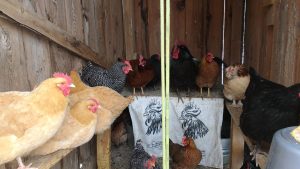Until recently, if you asked me about cold-weather chicken care, I would have said, “Choose the right chicken breeds for your climate and build your coop for your weather conditions.” With iguanas freezing and falling out of trees in Florida and alligators using weird ice-survival strategies in North Carolina, I have realized that answer needs an addendum.
Let’s face it. Our climate is changing. As a result, weather patterns are becoming more extreme and erratic. We have to start preparing for worst-case scenarios in our livestock care.
We also have to be ready to act quickly because weather patterns and predictions are not as reliable as they used to be. This past winter, for instance, it wasn’t unusual for me to wake up to a few inches of snow when the previous night’s forecast said there was a 0% chance of precipitation. Having a repertoire of simple solutions using things you already have on hand is really helpful.
There are four articles in this series on different strategies for cold-weather chicken care. To read the others, click on the links below:
- “How to Prevent (and Treat) Frostbite in Chickens”
- “The 13 Best Chicken Breeds for Cold Climates”
- “How to Keep Chicken Water From Freezing”
In this article, I want to kick things off with some easy strategies you can use to keep your chicken coops comfortable during unexpected cold snaps.
Adult chicken body temperatures run around 105-107°F. A chicken’s body temperature can drop as low as 73°F before it will die of hypothermia. Chicken feathers do a darn good job of trapping body heat, so luckily chickens don’t get chilled easily. However, if your chicken is molting when the cold hits, or has missing feathers due to roosters or hen-pecking, they will lose heat fast.
More from the Homestead Guru: 5 DIY Chicken Coop Designs That Wont Leave You Broke!
#1. Assess Chicken Feather Health
As a first step to cold weather chicken care, assess the feather health of your flock. Any birds with missing feathers may need special care for the duration of any unseasonably cold periods. Also, if you have Mediterranean breeds, that are lightly-feathered, treat those breeds as you would a more hardy chicken in mid-molt.
If you are facing extreme cold and have a half-naked chicken in your un-insulated, unheated coop, you may also have to consider moving that chicken to a heated area or offering heat in the coop. For less severe conditions, some of the following tricks might be enough to keep your at-risk birds, and the rest of your flock, cozy in the cold.
#2. Make a Chicken Sweater
For birds with feather damage mainly in the saddle area (the back), you can consider using a chicken sweater to help protect your chicken’s skin from the cold. You can make or buy fancy versions like those found on Pinterest and Etsy (just search “chicken sweater”). Or you can also just cut up an old sweatshirt, blanket, or towel and use twine to make as less-fashionable, still-functional version.
#3. Create a Chicken Couch
Feather loss in the bum area is a bit more tricky to protect though, since that’s also the drop zone for chicken poop. Provide butt-naked chickens with warm places to sit (other than the nest boxes) by adding lots of extra litter to your coop floors or filling empty boxes with straw, hay, or wood shavings to make chicken couches. Just be careful not to make your chicken couches too cozy, such as by providing head cover or tucking them into a dark corner, or your cold-weather couches might get mistaken for new nest boxes.
More From the Homestead Guru: DIY Chicken Tractor for $150
#4. Up Your Chicken Feed and Offer More Cracked Corn
Chickens eat more food in cold weather in general. However, in extreme cold, you want to make sure they have access to an all-you-can-eat buffet of high quality chicken feed so they don’t burn through their fat stores trying to keep warm.
Extra carbohydrates can also help chickens keep a bit warmer. I increase the amount of cracked corn in my fermented scratch grains during cold-weather snaps. Scratch grains are not the most nutritious food source, but just like humans have a cup of hot cocoa to warm up on a cold day, a little carb-loading in extreme cold can be helpful.
Read More: “Ferment Your Feed for Healthier and Happier Chickens”
#5. Shrink Your Chicken Coop Space
Hatcheries ship young chicks in batches and small boxes, even in cold weather. By forcing chicks to huddle together, they keep each other warm in a confined space.
You can offer your adult chickens a similar option by using stacked straw or hay bales or plywood to make larger coops smaller and force chickens to group together. A smaller coop, coupled with the cold, may make them a bit moodier, though. So scatter scratch in your coop floor or hang a cabbage on a rope to give chickens something to do during forced confinement.
#6. Shrink Your Chicken Roost Bar Area
If you have extra roost bar room in your coop, consider taking out a bar or two to force chickens to roost closer together at night. It may mean getting out your drill to detach a bar. But this might be easier than trying to rig up a way to supply supplemental heat for really cold nights, particularly in an off-grid coop.
#7. Cover Hardware Cloth Windows
If you live in warmer areas and have hardware cloth windows for good ventilation, you may want to consider covering them with clear trash bags temporarily. This still allows in light while also helping trap more heat in your coop during cold spells. Keep in mind that chickens still need ventilation so they don’t develop respiratory issues as a result of inhaling too much ammonia. If your coop is already super-sealed in other ways, then covering your only ventilation source with plastic might not be the best option for you.
More from the Homestead Guru: How to Enjoy Fresh Flavors Year Round + 5 Easy Indoor Herbs
#8. Put Up a Tarp Tent
Similar to covering windows, if you have coops that you can stand up in, then putting up a tarp tent in cold weather can help trap the warm air generated by your chickens closer to the ground and roost bars where chickens spend most of their time.
Since my coop is shed-style with wood slat walls, I can just use a few scraps of wood, a handful of screws, and a tarp to make my coop into a fortress of warm air. But if you don’t want to drill holes in your coop walls, then you can also rig up a tarp using ropes, bungee cords, and even things like Velcro to make it work.
#9. Bring in the Hot Water
I give my chickens buckets of warm water to drink on freezing days because it takes longer for the water to freeze and buys me time before I have to bring them another bucket. Chickens also seem to love drinking hot water as a cold weather pick-me-up.
Bringing in a five-gallon bucket of hot-as-you-can-get-it water and placing it in the center of your coop, particularly after you have shrunk your chicken space and put up a tent, can also help warm the area. Similarly to how we use drums of water in a greenhouse, all that heat in the bucket will dissipate out in the small coop area and infuse the air with more warmth.
Now, you won’t get big gains with this little trick, but sometimes all you need is a few extra degrees to avoid having to think about electric heat. Also, keep in mind that water weighs about eight pounds per gallon, so you may want to fill the bucket halfway and then top it off with water from another bucket to lighten your load.
#10. Install a Heat Source
In really extreme conditions, you may need to use drastic measures—like running a power cord to your coop and adding some kind of space heater. It’s important to think about safety when you go this route. Cold, confined chickens are liable to have a few more disputes than happy, foraging, spring chickens, which means they could accidentally bump into your heat source and injure themselves or knock over your device and start a fire.
Rather than trying to heat the whole coop, create a cozy corner by hanging a brooder lamp or setting up a ceramic heater in a less-traveled area of your coop. Cold chickens will flock to this area, while hot-tempered, more energetic chickens might keep their distance. And check on your heat sources and your chickens often to ensure their safety.
#11. Turn Off Your Laying Light
A lot of people use supplemental light to induce chickens to lay eggs in the winter months. However, in extreme cold, your chickens are already working overtime to keep themselves warm. So, unless you are also offering supplemental heat to keep your coop well above freezing, then consider giving your layers a break and turn off your laying light until temperatures pick back up.
There are many more great ways of keeping your chickens warm in the cold, both on and off grid. If you have some good ideas you want to share with our community, please include them in the comments section below.
And remember, your chickens rely on you to take great care of them and to do that, you also need to take great care of yourself. So, check out these other posts to help you stay warm and healthy, too!
Read More: “3 Tips for Working Outside in the Cold”
Read More: “Mustard Greens: What You Need to Know Before You Grow (With Recipe)”
Then, let us know in the comments:






